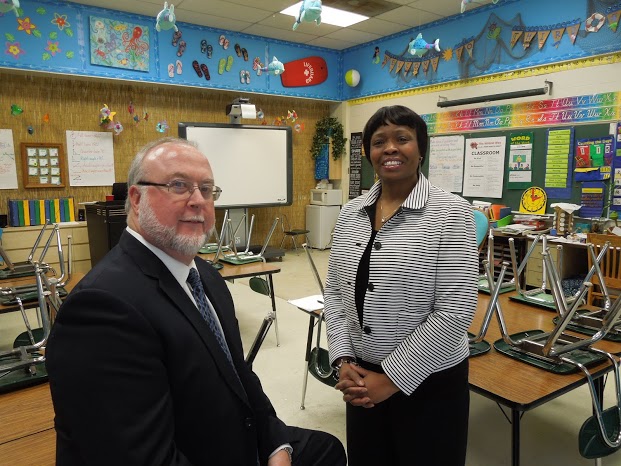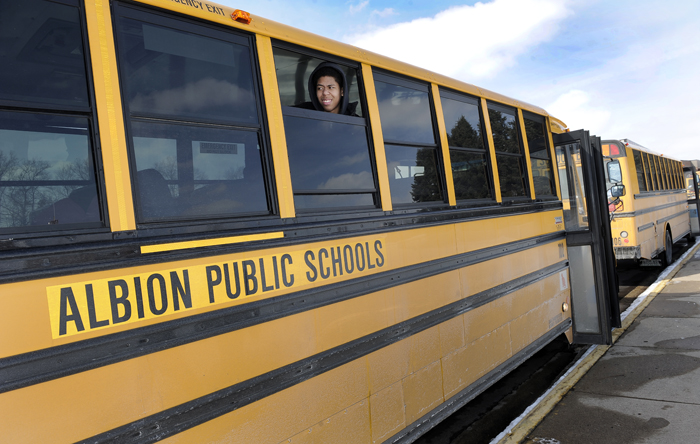13 MILES TO MARSHALL: Are Albion and Marshall a model for other troubled districts? (chapter 3)
13 MILES TO MARSHALL
There’s an old joke that superintendents know.
“What do you call a superintendent who closes a school?”
“An ex-superintendent.”
Closing a town’s high school, and busing more than 150 poor, mostly black kids to a middle-class, white school seemed like potential career suicide for Williams-Harper and Davis.
“A lot of people think it’s a good idea, but nobody wants to do it in their place,” Williams-Harper said. “It could be a serious career-changer.”
In business terms, the plan made sense. Closing Albion’s high school, which costs more per student than K-8 classes, would drastically lower the struggling district’s bills. (Albion retained its K-8 classes and is still an independent district.) An influx of Albion students and their $7,000 in state aid would help erase Marshall’s deficit.
Albion would shoulder the cost of transporting their teens to Marshall for school and after-school activities, and Marshall’s standardized test scores were likely to drop. But those were small problems compared with the business struggles the districts would face if they did nothing.
But communities don’t view their schools as businesses.
The racial disparity between the schools couldn’t be ignored. “We had a low-income district, basically all minority, going to a white, affluent district,” Williams-Harper said. “They said they didn’t know if they’d be treated fairly. By the reaction, we thought it was 1960 all over again.”
Parents seemed more worried about race than many of their children. “I think it was a generational thing,” said Jerome Washington, a senior from Albion who is African-American. “I think they (parents) are getting the hang of it now.”
Some Marshall parents encouraged Superintendent Davis to hire more security staff for the high school once Albion students arrived. He refused.
“What we were hearing was all negative, basically racist stuff,” recalled Samantha Price, a Marshall junior, who is white and an outspoken advocate of the joined high schools. She believes that while the benefits of the collaboration aren’t as tangible for Marshall students, there is value in pushing out of their white, middle-class cocoon. “This is the real world,” she said. “They’re just regular students like us.”
No Wildcats, no town: Why consolidations are rare
Albion’s angst went beyond race, to an issue that makes school consolidation a difficult sell in any community.
“As long as you have a high school, you’ve still got a town,” said Linda Forward, who as director of education improvement and innovation at the Michigan Department of Education, prods districts to collaborate. Forward was instrumental in steering Albion and Marshall through the high school merger, but has struggled to get other communities to do the same.
Loss of identity is tough to overcome, even when merging high schools makes sense economically and academically.
When you have a high school, “you’ve got the Bearcats or Tigers,” Forward said. “You’ve got the red-and-white.”
High school sports plays an oversized role in education policy. Forward recounted a story from when she was principal of tiny Millington High School in Michigan’s thumb, when to save money she recommended to the school board that the school drop its sports teams. “There was an auditorium full of people and we were there till 2 a.m.,” Forward recalled.
Sports were retained.
“The next month, we were evaluating new textbooks for reading. There were four people there and we were out in 90 minutes.”
Felicia Gardenhire said she was “one of those parents” complaining the loudest about the closing of Albion High School last spring. “I graduated from Albion,” she said. “My mom graduated from Albion. My son graduated from Albion. I wanted my daughter to graduate there, too.”
But after seven months at Marshall, Gardenhire and her daughter Tamiyah, a freshman, are converts. “The teachers are great,” Felicia Gardenhire said. “The parents are great. She’s making lots of friends.”
“I love it,” Tamiyah said, turning her attention back toward a text message.
The Marshall-Albion collaboration may not have happened if not for the two people heading the districts. Davis, 57, the Marshall superintendent, who is white, started his career as a family therapist, working at Starr Commonwealth in Albion, a nonprofit that focuses on racial healing.
Williams-Harper, 55, who is black, has never shied away from a fight. She had public confrontations with the school board of Beecher Community Schools on the north side of Flint when she was superintendent of that struggling, low-income district. She was hired as Albion superintendent in July 2012. Within three months, she was working with Davis to close Albion’s high school.
“This couldn’t have been done from the inside, by someone who’s been here 25 years,” Williams-Harper said. “I still have people who won’t talk to me because I’m the woman who closed the high school.”
Albions all over Michigan
Albion was one of about 50 Michigan school districts in the red at the end of the last school year, many with deficits larger than Albion’s.
Brighton Area Schools in Livingston County was operating at a deficit; so were school districts in Mt. Clemens, in Macomb County and Menominee in the Upper Peninsula. Benton Harbor Area Schools has a deficit equal to 43 percent of its revenues; Ypsilanti’s deficit totaled $9 million.
Forward said she has encouraged districts to consider the entire spectrum of collaboration, from complete mergers to sharing back-office personnel, to save money. “Do you really need four bookkeepers,” she will ask, “or can four districts share one bookkeeper?”
Sharing bookkeepers probably wouldn’t be enough to save Pontiac School District, which by last summer had a $75 million deficit equal to 39 percent of its revenues. Pontiac’s problems have a familiar ring: desperate cuts in an effort to save the district; fear of losing schools, concern about where its low-income, nearly all African-American students would go. The six surrounding districts are middle-class to upper-income, and majority white.
The uncomfortable truth is that collaborations that send kids from a struggling district to a financially sound district are always a tough sell, and even tougher when they change the color of classrooms.
Is financially troubled White Cloud School District in rural Northwest Michigan more likely to form an Albion-Marshall type of collaboration than Pontiac because its kids are virtually indistinguishable from students in neighboring Fremont and Newago?
By contrast, if Pontiac officials were inclined to bus its high schoolers to another district – a move that would save money while offering teens more opportunities – would the district find any suitors?
That’s why the success or failure of the Albion-Marshall merger will be watched closely by school leaders across Michigan. If schools of different incomes, races, cultures and academic success can combine successfully, it could spark more high school consolidations. If it fails, Forward’s job will be that much tougher.
“There are districts that should be looking at their data and figuring out what they need to do,” Forward said. Until the Albion-Marshall story unfolds, “there’s no recipe book with those ingredients in it.”
Editor's note: As originally posted, this story overstated the amount of the Ypsilanti deficit. It has been corrected; Bridge regrets the error.
13 MILES TO MARSHALL
CHAPTER 4
Michigan Education Watch
Michigan Education Watch is made possible by generous financial support from:
Subscribe to Michigan Education Watch
See what new members are saying about why they donated to Bridge Michigan:
- “In order for this information to be accurate and unbiased it must be underwritten by its readers, not by special interests.” - Larry S.
- “Not many other media sources report on the topics Bridge does.” - Susan B.
- “Your journalism is outstanding and rare these days.” - Mark S.
If you want to ensure the future of nonpartisan, nonprofit Michigan journalism, please become a member today. You, too, will be asked why you donated and maybe we'll feature your quote next time!


 Marshall Superintendent Randall Davis and Albion Superintendent Jerri-Lynn Williams-Harper faced heavy criticism for the high school merger last spring, but they said the move has paid dividends for both districts. (Photo by Ron French)
Marshall Superintendent Randall Davis and Albion Superintendent Jerri-Lynn Williams-Harper faced heavy criticism for the high school merger last spring, but they said the move has paid dividends for both districts. (Photo by Ron French) Albion students awake before dawn to make the 13-mile trip to Marshall daily. (Photo by Lon Horwedel)
Albion students awake before dawn to make the 13-mile trip to Marshall daily. (Photo by Lon Horwedel)
